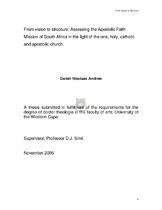| dc.description.abstract | The intention of the AFMSA to revision its policies, processes and structures is the motivation for this study. The relationship between the vision and essential nature of the church and the structure or form given to it is central to all the chapters.The first chapter gives an analysis of the origins of the Pentecostal Movement and the AFMSA in order to reveal their original vision of the church and the way in which this vision became structured in their history. After a section on the importance of a clear vision and strategic structures for organizations today, the biblical metaphors that served as a foundation for the early Christians’ vision of the church are discussed. Our Christian predecessors’ envisioning and structuring of the church in each period of history are analyzed. This gives an idea of the need for reform and the challenges involved in this process, which are still faced by later generations. The historical survey reveals the development of the marks and the vision of the early Christians to represent the one, holy, catholic and apostolic church. In the conclusion, a preliminary dialogue is established between the vision of the early Pentecostals and the leaders of the AFMSA with regard to the structuring of the church and other expressions of the same vision.The next four chapters (2-5) address the significance of the specific marks in the Pentecostal Movement and the AFMSA. This is followed by a short analysis of the biblical foundation and the historical development of these marks in the history of the Christian church. The chapters are arranged according to the prominence of each mark in the Pentecostal Movement and the AFMSA. Chapter two therefore starts with the apostolicity that is followed by the holiness in chapter three, unity in chapter four and catholicity in chapter five. It becomes clear from chapter two that the Pentecostal Movement and the AFMSA want to restore the apostolic faith of the early Christians while the rest of the Christian church confess every Sunday through the Apostles’ Creed and the Nicene Creed that they believe they stand in the tradition of the apostles. The mark of holiness that is discussed in chapter three expresses the particular view of holiness held by Pentecostals. Biblical and historical connections are made between it and other Christian expressions revealing that we can all become true followers of Christ in holiness. Chapter four addresses the fact that the church has to accept that we exist as a unity in diversity. In chapter five, the linking of all traditions is established because all have the challenge to share their unique expression of God’s fullness with the universal Body of Christ. In chapter six, all the elements so far discussed: the vision of the church that was based on the Bible, and the history of the Pentecostal Movement, AFMSA and of the Christian Churches are summarized to gain an overall perspective. This is followed by an analysis of the vision of the church today and applied to the AFMSA. The AFMSA is encouraged to revision and restructure itself in the light of the apostolicity, holiness, unity and catholicity that are shared by the witnesses in Scripture and history so that it will be an example of God’s vision for the church and the world. | en_US |

